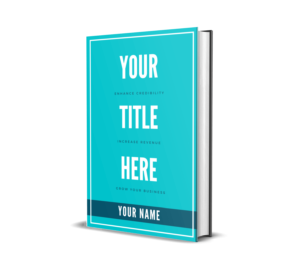How to Create the Perfect Nonfiction Book Title
You have about eight seconds to capture someone’s attention. It’s pretty easy to see the importance of creating the perfect nonfiction book title.
Think about all the work you will put into your book. Think of all the valuable information you will pour onto the pages of your manuscript.
All the outlining, planning, writing, editing—all of it could end up being overlooked if you don’t have an appealing title.
Imagine yourself browsing Amazon for your next read. Pretend you’re in the earliest days of your business and you’re looking to scale your company. You type business growth books into the search bar and over 100,000 results appear.
In a perfect world, you would have time to read hundreds of those books. But in reality, your time is limited, and you can only choose one.
Want to write a book in 2022?
You begin to scroll through the results. What are you looking for? What catches your eye immediately?
The cover is one component, but what do you do immediately after? You see what the book is titled, don’t you? You read the title and subtitle to see if the information will be relevant to you.
When it comes to nonfiction, the title tells everything. The title teases the reader by telling them how their world can be transformed—how they can benefit.
Your potential readers are out there, but they are searching for your book in a sea of competing titles. When they search, they’re being cautious—even skeptical.
When on the hunt for the next book, they want to make sure they make the correct choice.
After all, time is of the essence. If someone is going to take the time to read your book, they want to know there’s value in it.
Main Title
The perfect nonfiction book title starts with the main title.
Here’s the deal when it comes to the main title: make it short, simple, and easy to remember.
Your goal with the title is to be able to say it to another person without them asking you to repeat it or explain the meaning.
Think back to a podcast you listened to where the guest said the name of their book, website, or business, and you couldn’t understand a word of it until they spelled it out or enunciated.
Imagine how frustrating it must be for that person to clarify their title every time they speak with someone.
Every. Single. Time.
You don’t want that, do you? Of course not. You want to be able to quickly and easily announce the title of your book. It needs to be short and sweet.
Zero to One
Shoe Dog
Rich Dad Poor Dad
These are short, sweet, and simple. You could easily tell someone the title of one of these books and no second guessing or confused looks would come in response.
HINT: If you want your book to spread through word-of-mouth marketing, this is critical.
What these examples lack, however, is context. They don’t clearly explain what the book is about.
But that’s perfectly fine. There’s no need to focus on context with the main title.
That’s what the subtitle is for.
Subtitle
Subtitles provide the context that’s missing in your title. While your title is attention-grabbing and intriguing to your potential reader, the subtitle tells them exactly what they will learn from reading your book.
Zero to One: Notes on Startups, or How to Build the Future
Shoe Dog: A Memoir by the Creator of Nike
Rich Dad Poor Dad: What the Rich Teach Their Kids That the Poor and Middle Class Do Not
The short, snappy titles are supported by their longer, more detailed subtitles. They provide descriptions. With these subtitles attached, the main titles make more sense.
But the subtitle has further importance. It is where keywords start to become important.
Using Keywords in Your Title
Think of your typical online search—a Google search, for example.
You go to a search engine, type in a few keywords, and within a second or two, millions of results appear.
How are they found? How does the search engine know which results to put in front of you? It has everything to do with keywords.
Write your book and have it published to Amazon, Barnes & Noble, and more…
E-commerce is the new way of shopping, and you need to ensure your strategy revolves around this face.
Ask yourself questions your target reader is looking to have answered. What are key terms your target reader will search for? Are there typical phrases or acronyms in your industry that stand out?
There are plenty of online resources for finding keywords in your industry. You can use a search engine optimization (SEO) keyword tool like SEMrush or Google Keyword Planner to do some research into keywords within your industry.
Tread lightly here, though. Especially when it comes to your book’s main title.
Don’t start keyword stuffing with the hopes it will place your book high on search engine results pages.
Websites can determine if you’re keyword stuffing—meaning you place a bunch of relevant keywords into a title or description, resulting in a phrase or title that makes no logical sense—and you will be penalized for doing so. Amazon, for instance, penalizes this by dropping you farther down the results pages.
If keywords are used effectively, however, your book can benefit.
Using Your Business Name
If you have a business, course, mastermind group, or so forth with a trademarked or copyrighted name, consider using it.
A great branding strategy involves having uniformity across all offerings.
This can work well for people whose business can be explained through their title, or those who have trademarked their business’s name.
Having your business title as your book title can help with branding, word-of-mouth marketing, SEO, and many other areas of promotion for both your business and your book.
Where to Find Inspiration
Not sure where to start? Go to where books are sold. Online or in-store, your choice.
Search for books in your category. Preferably, look at the best-sellers. Are their titles long or short? One word? Three words? Five? Take out your phone and make a note about trends you see.
Then, start observing subtitles. What are some commonly used words? These will be your keywords. Write those down, too, so that you can go to SEMrush or Google Keyword Planner and do some research.
Throw some of your own opinions into the mix as well. Do you have a piece of unique intellectual property you want to add? Is there a catchy, relevant phrase you use inside your business that can work well as a title, or part of a subtitle?
Take all your research, notes, and thoughts and brainstorm. Compile a list of potential titles and subtitles, then test them. Ask people who are categorized as your target reader for their opinions and make a decision from there.
Need help getting started with your nonfiction book project? We’re here and ready to help.
Speak with one of our publishing experts to learn more about the steps you need to take to become a published author.


